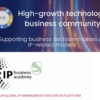MIPLM 2021 module 5: Design Thinking and IP-Design in the digital transformation
The 5th module of the MIPLM program is about human resource management (HRM), leadership and management control systems. The digital transformation is not a passing phase: It is the next evolution level of industry. Companies require a digitally adapted new kind of leadership and strategy. The digital transformation has brought about a myriad of growth opportunities as well as unprecedented challenges. For example, it has redefined the boundaries between partners and competitors. In many industries the digital transformation has lowered the barriers to entry, making it easier for newcomers from other industries and with different technologies to compete, oftentimes more aggressively and briskly.
 The digital transformation brings about great challenges for leaders of business organizations who now have to deal with disruptive changes in the commercial landscape, with data-driven decision making, as well as with new ways of crowd-based working; and with a workforce with ubiquitous access to information and establishing new ways of communication. In this module, we discussed leaders’ perspectives on these digitalization-driven developments. Leaders, as the focus of our analysis, discuss environmental changes of leadership as well as updated practices of leaders’ communication with their followers. In addition, we discussed leaders’ self-reported context dependence of their individual leadership styles. The lecture contributed to a more integrative view of the interplay of digitalization and leadership and to the thinking on whether the assumptions of leadership theories of the non-internet era are still valid.
The digital transformation brings about great challenges for leaders of business organizations who now have to deal with disruptive changes in the commercial landscape, with data-driven decision making, as well as with new ways of crowd-based working; and with a workforce with ubiquitous access to information and establishing new ways of communication. In this module, we discussed leaders’ perspectives on these digitalization-driven developments. Leaders, as the focus of our analysis, discuss environmental changes of leadership as well as updated practices of leaders’ communication with their followers. In addition, we discussed leaders’ self-reported context dependence of their individual leadership styles. The lecture contributed to a more integrative view of the interplay of digitalization and leadership and to the thinking on whether the assumptions of leadership theories of the non-internet era are still valid.
Prior to diving into the implications on HR functions, it is important to identify selected organizational implications of the digital economy: Increasingly, responsibility is sitting closer to where decisions are most effective. Organizations are flatter and decision-making leaner:
- Leaders have always focused on outcomes. With the digital transformation, there are technological enablers that make it possible to measure and test the soundness of decisions quickly and easily.
- Mobility and flexibility are crucial for employees to remain relevant in the digital economy. Accordingly, competencies are transferable and internal and global movements are more appealing to both employers and employees.
 So, the HR dilemma no longer lies solely between cost savings and value added. Instead, HR’s concerns will soon be revolving around the changing nature of the organization and employees becoming increasingly digital and influenced by the following disruptive themes:
So, the HR dilemma no longer lies solely between cost savings and value added. Instead, HR’s concerns will soon be revolving around the changing nature of the organization and employees becoming increasingly digital and influenced by the following disruptive themes:
- Digital mega trends, including but not limited to, cyber, data, cloud, social and mobile.
- A multi-generational workforce including Millennials or first-generation digital citizens.
- Merging work and life with hyper- connected employees.
- Emergence of a new set of digitally skilled employees.
- Business models under stress from digital disruption.
The employee is perceived as the first consumer of the employer’s brand. HR needs to be more preemptive regarding the digital transformation as it plays an important role in shaping the organization’s digital identity. It is a challenge and a real complexity to plan future capabilities of a workforce in the digital economy; as is the ability to integrate the right people into a dynamic organizational context and help existing employees and leaders gain new digital competencies to be able to drive transformation.

To be successful in the new generation of business eco-systems that is based on innovation, collaboration, and digital transformation we need whole-brain skills that fosters creative business leadership and increases the effectiveness of human centered Lean and Design Thinking methodologies.
- creativity
- thinking out of the box
- ideation
- observation
- contextual thinking
- asking good questions
- pattern recognition
- empathy
- emotional intelligence
- inspiration
- concretization
In recent years, the “Artful Thinking” mindset, that is supported by most reputable academic institutions such as Harvard and MIT, has become the most distinctive way to develop these whole-brain skills. In the following movie, John Maeda is explaining the link between design thinking and creative leadership:
Cannot open the video? Please click: https://www.youtube.com/watch?v=MjSOjwixR4k



